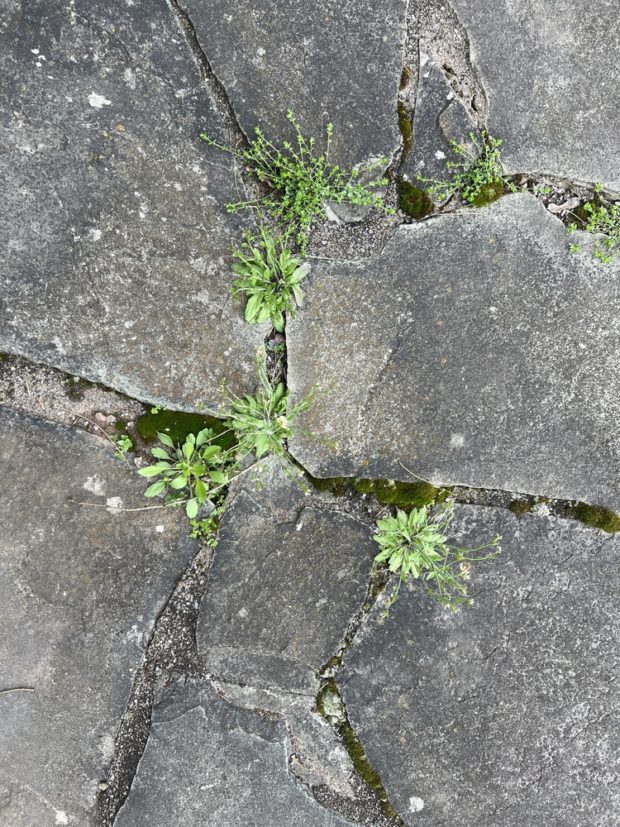Maintaining hardscapes, such as driveways, patios, and walkways, involves more than just ensuring their structural integrity and aesthetic appeal. One of the most persistent and challenging issues homeowners face is the growth of weeds. Effective hardscape weed control requires a combination of proactive measures, regular maintenance, and the right techniques. In this blog, we’ll explore the best methods for controlling weeds on hardscapes and provide practical weed control tips to keep your outdoor spaces looking pristine.
Why Weeds Grow in Hardscapes
Weeds can find their way into the smallest cracks and crevices of hardscape surfaces. Factors contributing to weed growth include:
- Soil and Debris Accumulation: Over time, soil and organic matter accumulate in the joints and cracks of hardscapes, providing a suitable environment for weed seeds to germinate.
- Moisture: Hardscapes can retain moisture, especially in shaded areas, creating a perfect breeding ground for weeds.
- Seed Dispersal: Weed seeds are easily dispersed by wind, water, animals, and human activity, making it challenging to keep hardscapes weed-free.
Hardscape Weed Control Methods
1. Manual Weed Removal
Manual removal is often the first line of defense against weeds. This method includes:
- Hand Pulling: For small infestations, pulling weeds by hand can be effective. Ensure you remove the entire root to prevent regrowth.
- Weed Tools: Tools such as weed knives or dandelion diggers can help extract weeds from hard-to-reach places.
Pros and Cons
Pros:
- Immediate results.
- No chemicals involved.
Cons:
- Labor-intensive.
- Temporary solution if roots are not entirely removed.
2. Chemical Weed Control
Herbicides can be effective in managing weeds on hardscapes. There are two main types:
- Pre-emergent Herbicides: These prevent weed seeds from germinating and should be applied before weeds start to grow.
- Post-emergent Herbicides: These are used to kill existing weeds. They are available in selective (targeting specific types of weeds) and non-selective (killing all plants) formulations.
Application Tips
- Follow the manufacturer’s instructions for safe and effective use.
- Apply during calm weather to prevent drift to desirable plants.
- Wear protective clothing to avoid skin contact.
3. Natural Weed Control Methods
For those who prefer eco-friendly solutions, natural weed control methods include:
- Boiling Water: Pouring boiling water directly onto weeds can effectively kill them. This method is suitable for small areas.
- Vinegar: A solution of vinegar and water can act as a natural herbicide. Use a higher concentration of vinegar (20% acetic acid) for tougher weeds.
- Salt: Sprinkling salt in the cracks can prevent weed growth. However, be cautious as salt can also damage nearby plants and soil health.
Pros and Cons
Pros:
- Environmentally friendly.
- Safe for use around pets and children.
Cons:
- May require multiple applications.
- Less effective on well-established weeds.
4. Mulching
Mulching can help suppress weed growth by blocking sunlight and creating a barrier. Types of mulch suitable for hardscapes include:
- Organic Mulch: Materials like wood chips or straw.
- Inorganic Mulch: Gravel, pebbles, or landscape fabric.
Application Tips
- Apply a thick layer (2-4 inches) to effectively block sunlight.
- Replenish mulch regularly as it decomposes or shifts.
5. Mechanical Methods
Mechanical weed control involves using equipment to manage weeds, including:
- Power Washers: High-pressure water can dislodge weeds from hardscapes.
- Flame Weeders: These devices use propane to create a flame that burns weeds. Use with caution to avoid fire hazards.
Pros and Cons
Pros:
- Effective for large areas.
- Reduces the need for chemicals.
Cons:
- Requires equipment investment.
- Potential safety risks.
Preventive Weed Control Tips
Maintain Your Hardscape
Regular maintenance can help prevent weed growth. Tips include:
- Seal Cracks: Fill and seal cracks in your hardscape to prevent soil accumulation.
- Clean Regularly: Sweep or blow debris off your hardscape to reduce the chances of weed seed germination.
- Proper Drainage: Ensure your hardscape has proper drainage to prevent moisture buildup.
Use Weed Barriers
Installing weed barriers under hardscape surfaces can prevent weed growth. Options include:
- Landscape Fabric: Place this fabric beneath hardscapes to block weeds while allowing water to pass through.
- Plastic Sheeting: A more durable option, but it can interfere with water drainage.
Choose the Right Plants
If you have plant beds adjacent to hardscapes, choose plants that can outcompete weeds or use ground covers that spread and shade the soil, making it difficult for weeds to establish.
Conclusion
Effective hardscape weed control requires a multifaceted approach, combining manual, chemical, natural, and mechanical methods. Regular maintenance and preventive measures are crucial to keep your hardscapes weed-free. By following these weed control tips, you can maintain the beauty and functionality of your outdoor spaces without the persistent nuisance of weeds.
Need a Hardscape Contractor in Raymore, MO?
Since 2004, MSE Hardscape Design and Installation has been the expert provider and installer of retaining walls for the city of Kansas City and its surrounding areas. We are dedicated to providing exceptional and professional services to our valued customers. Our specialty lies in the design, installation, and maintenance of retaining walls for both commercial and residential spaces. We offer many services to meet the needs of our customers, including the building and installation of segmented block and large-block retaining walls, interlocking pavers, fire pits, outdoor kitchens, and pizza ovens. Our goal is to create an oasis out of your backyard or commercial space! Call us today for a consultation!

